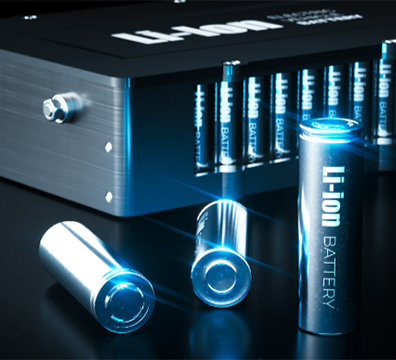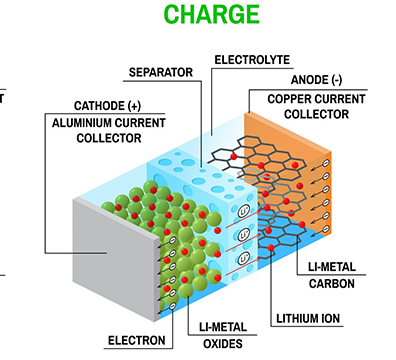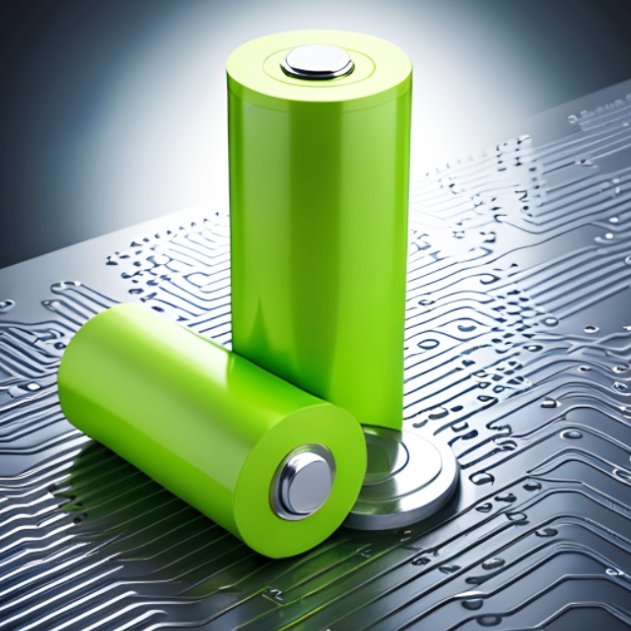Common Parameters and Formulas for Lithium-ion Batteries
(1) Theoretical Capacity of Electrode Material
The theoretical capacity of the electrode material, assuming that all lithium ions in the material participate in the electrochemical reaction, is calculated using the following formula:
Theoretical capacity(mAh/g)=Faraday constant F (C/mol)*Li’quantity*[1/molecules‘qunatity(mol/g)]*[1/3.6(mAh/C)]
Where the Faraday constant (F) represents the charge carried by each mole of electrons, with a unit of C/mol. It is the product of Avogadro’s number (NA = 6.02214 × 10^23 mol^-1) and the elementary charge (e = 1.602176 × 10^-19 C), with a value of 96485.3383±0.0083 C/mol.
Therefore, the formula for calculating the theoretical capacity of mainstream materials is as follows:
For LiFePO4 with a molar mass of 157.756 g/mol, its theoretical capacity is:
Theoretical capacity(mAh/g)=96500(C/mol)*[1/157.756(mol/g)*[1/3.6(mAh/C)]=170mAh/g
Similarly, for NCM(1:1:1) (LiNi1/3Co1/3Mn1/3O2) with a molar mass of 96.461 g/mol, its theoretical capacity is 278 mAh/g. For LiCoO2 with a molar mass of 97.8698 g/mol, its theoretical specific capacity is 274 mAh/g if all lithium ions are removed.
For graphite anode, when the maximum lithium insertion occurs, forming lithium-intercalated compound with a chemical formula LiC6, i.e., 6 carbon atoms combined with one Li. The maximum theoretical capacity of graphite is:
Theoretical capacity(mAh/g)=96500(C/mol)*[1/72.066(mol/g)*[1/3.6(mAh/C)]=372mAh/g
For silicon anode, considering the reaction 5Si + 22Li+ + 22e- ↔ Li22Si5, the theoretical capacity of silicon anode is:
Theoretical capacity(mAh/g)=96500(C/mol)*[22/140.430(mol/g)*[1/3.6(mAh/C)]=4200mAh/g
These calculated values represent the theoretical specific capacity, and to ensure reversible material structure, the actual lithium ion extraction coefficient is less than 1. The actual specific capacity of the material is given by: Actual Specific Capacity = Lithium Ion Extraction Coefficient × Theoretical Capacity.
(2) Battery Design Capacity
Battery design capacity = Coating areal density × Active material ratio × Active material specific capacity × Electrode coating area
Where areal density is a key design parameter controlled mainly during coating and rolling processes. When the compact density remains constant, an increase in coating areal density means an increase in electrode thickness, electron transfer distance, and electron resistance, but the increase is limited. In thick electrode sheets, the increase in migration impedance of lithium ions in the electrolyte is the main reason affecting the rate performance. Considering the twisting of pores and pores, the migration distance of ions in the pores is much larger than the thickness of the electrode.
(3) N/P Ratio
N/P Ratio = (Negative electrode active material specific capacity × Negative electrode areal density × Negative electrode active material content ratio) / (Positive electrode active material specific capacity × Positive electrode areal density × Positive electrode active material content ratio)
For graphite anode-based batteries, the N/P ratio should be greater than 1.0, typically between 1.04 and 1.20, mainly for safety design to prevent lithium precipitation in the negative electrode. Design considerations should account for process capabilities, such as coating deviations. However, when the N/P ratio is too large, irreversible capacity loss occurs, leading to reduced battery capacity and lower energy density.
For lithium titanium oxide (Li4Ti5O12) negative electrodes, an excess positive electrode design is adopted, and the battery capacity is determined by the capacity of the lithium titanium oxide negative electrode. Excessive positive electrode design is beneficial for improving the high-temperature performance of the battery. The main source of high-temperature gas comes from the negative electrode. In the case of excess positive electrode design, the negative electrode potential is lower, making it easier to form a solid electrolyte interface (SEI) film on the surface of lithium titanium oxide.
(4) Compaction Density and Porosity of the Coating
In the production process, the coating compaction density of the battery electrode sheet is calculated using the formula:
Coating compaction density=coating areal density after rolling/【thickness of the electrode after rolling-original thickness of the metal foil/(1+foil elongation rate)】
Considering the elongation of the metal foil during rolling, the coating areal density after rolling is calculated using the following formula:
Coating areal density after rolling=coating areal density/(1+foil elongation rate)
The coating consists of active material phase, carbon gel phase, and pores. The formula for calculating porosity is:
Porosity=1-coating compaction density/average coating density
Where the average density of the coating is:
Average coating density=1 /【active material ratio/active material density+conductive agent ratio/conductive agent density+binder ratio/binder density】
(5) First Coulombic Efficiency
First Coulombic Efficiency = Initial discharge capacity / Initial charge capacity
In daily production, it is generally first converted and then separated. A portion of the electricity is charged during conversion, and after separation, it is discharged again. Therefore:
First Coulombic Efficiency = Initial discharge capacity / (Converted charge capacity + Separated discharge capacity)
(6) Energy Density
Volume Energy Density (Wh/L) = Battery Capacity (mAh) × 3.6 (V) / (Thickness (cm) × Width (cm) × Length (cm))
Mass Energy Density (Wh/KG) = Battery Capacity (mAh) × 3.6 (V) / Battery Weight







